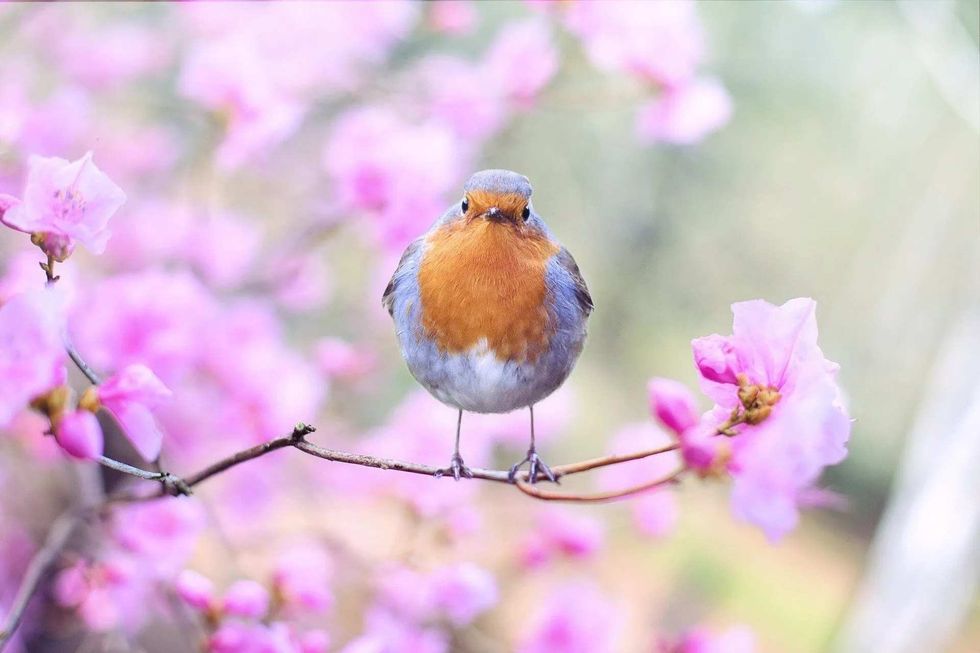Robins, known to be quite the songbirds, can nest in almost any place.
Until the 20th century, the robin was commonly called 'redbreast'. They can fight until death with other robins to defend their nest or territory!
These birds come from the thrush family and they are closely related to nightingales and blackbirds. In general, there are three types of robin species.
These are the American robin, the rufus-backed robin, and the white-throated robin. This bird, which has been declared by Britain as the national bird twice (although not officially), is omnivorous and eats anything from plants to insects but its favorite food is worms and robins eat them in plenty!
The consumption of worms provides robins with a lot of calories.
This bird will often hop around in a garden or a lawn, feeding on worms along with small seeds or insects that it can find. A robin's plumage is normally brown or gray with a red underside.
The male robin tends to be more brightly colored than the female robin. These birds are known to have interesting breeding patterns and styles.
Considered to be early breeders, robins can begin mating and breeding in the winter season although the breeding season usually takes place in the month of March and then spreads from April until July. During the courtship period, a male robin feeding a female worms is a very prominent activity.
Most bird species lay their eggs when the sun rises but this is not the case for robins. Robins lay their eggs usually during the mid-morning period!
During the breeding season, the mother robin will feed on a lot of worms to give her more energy during this time. Since worms are easily available during the hours before sunrise, robins will hunt for them in those dark hours.
Their nest is made in almost any location but it needs to be a concealed place and they show more of a preference in making their nests near the ground. The female robin is the one who builds the nest and the nest is built in a cup-like shape.
Items like scraps, pieces of paper or metal, strings, hair, mud, small twigs, leaves, grass, and even flower petals are used when the robin nest is built.
If the nest is made on a tree, these materials that are used to make the nest work well in serving as a camouflage from predators. The robin pair (both the male and the female) are very careful and conscious during the nest-building and egg-laying period.
Therefore, they will abandon their nest if they feel like it has been discovered by other predators or birds and the pair will go make a new nest!
Once the nest is ready, a mother robin lays one egg each day and a total of about three to four eggs is laid, now a clutch. If you didn't know before, each robin's egg is a bright blue color!
The eggs are blue in color due to a bile pigment called biliverdin that is deposited on the shell of the egg when the female lays it.
Scientific studies have claimed that the healthier the parents are, the brighter is the blue egg.
Scientists also believe that brighter blue eggs tend to make the males more attentive to their young because it was observed that they fed their baby birds twice as much. Once the female has laid a full clutch, she will keep the eggs cool so that all the eggs can hatch around the same time.
The mother may begin incubation of the eggs after the laying of the second egg or once the whole clutch is laid. They sit on the eggs for a period of 13 days or even 14 days.
Again, the incubating of the eggs is normally done by the mother and her body, as well as her feathers, providing the best heat to keep her eggs warm.
She will barely leave her eggs even on a day with perfect weather. To make sure that the eggs are warm all over, the female will hop onto the edge of the nest and slowly rotate or turn the eggs with her bill.
The male spends a less time sitting on the eggs but will mostly be watching over the territory and will come to the aid of the female when it raises a call of distress or alarm. The male plays a good role in looking after his mate by bringing food to the nest to feed her.
It takes about 14 days for the robin eggs to hatch after the mother lays them.
The hatching process of a young chick from the egg can go on for a whole day.
Robins are very good parents and have a high level of parental instinct, frequently feeding their chicks or babies with food. Once they hatch, the mother removes the eggshells from the nest or sometimes, consumes some of them for some extra calcium!
If you enjoyed this article on when do robins lay eggs, be sure sure to check out these articles on when do hummingbirds nest and when do hummingbirds lay eggs that you are sure to love!
Do robins lay eggs more than once a year?
The courtship period in robins begins early in January and they lay eggs in the spring season, in the month of March, and then extends from April to July.
Robins tend to pair up only for the breeding season, after their winter migration and then disband after that.
The robin's nest is usually built by the female with occasional help from its mate. The nests are built in any place but mostly near the ground and is made in such a way that the nest is hidden from any threats or predators.
Materials like small twigs, branches, grass, mud, and other scraps are used to make the nest as these elements help in hiding the nest in the tree or camouflaging it so that it is not very visible.
Robins generally lay eggs two to three times a year, with a clutch size of three to four eggs per brood. They mostly have two broods a year.
They lay their eggs in the mid-morning time and one egg is laid each day. The eggs are kept warm or incubated by the mother robin for a period of 13 days.
After 14 days, the eggs begin to hatch in the order they were laid in.
Once the robin eggs hatch, the eggshells are removed by the mother, or at times, she will eat a few of the shells for some extra calcium. The chicks hatch from the eggs naked and depend largely on the parents for both warmth and food like insects, small leaves, and worms.
Both parents look after the nestlings but the job is mostly done by the female. It takes about two weeks for the nestlings to fully fledge and fly from the nest to the world outside.
How many eggs do robins lay at a time?
Robins lay three to four blue eggs but they don't lay them all at once. These birds are known to lay one egg per day. If an egg is lost from its nest, it will lay another one.
This is why they lay eggs in a manner in which they stop only if and when they feel like the clutch of eggs is just right. The robin nest is built like a strong cup-shaped cavity, sometimes near the ground, so that it can be secure for the nesting season.
The mother robin takes great care in looking after the young hatchlings, both as robin eggs and as young chicks. Incubation by the mother alone goes on for a period of 13-14 days.
The female turns over the eggs to different sides by hopping onto the edge of the nest, turning them with the tip of her beak. The female does this several times a day!
By doing, she ensures that eggs get the same temperature on all sides and that the baby doesn't just stick to just one side. The mother develops a sort of brood patch that allows her to give more warmth directly from her body.
This brood patch is a lace on her belly where the feathers fall off, leaving naked skin.
She alternates heating the eggs depending on the weather of the day.
If it is a hot day, she will cover up with the outer feathers to decrease the heat, and in the winters she presses her eggs against the brood patch. Once the baby robins or nestlings come out of their eggs, the parents need to feed them a lot because they eat a lot for their growth and development.
What time of the year do robins lay eggs?
Robins lay their eggs between the middle of April to the middle of August. Robins can lay their eggs as early as March too! Once robin eggs hatch after incubation, a young robin baby comes out naked and blind.
The parents then take turns feeding the young ones and babies take two weeks to fully fledge and leave the nest. The way in which the babies or chicks hatch from the eggs is very interesting!
They hatch in the order in which the mother lays them in. For example, the egg that was laid on the first day hatches first and then the rest begin hatching accordingly.
As a result, the chick or baby robin from the egg that hatches first tends to be bigger than the chick that comes from the last egg.
Sometimes, due to lack of food, and in rare cases, the bigger chick eats the smaller chick. Robins can abandon their eggs or babies only when they feel like they will have slim chances of surviving.
Can robins lay eggs twice in a season?
Yes, it is possible that robins lay eggs twice or even thrice in a single season. With the parents sharing responsibilities, it is possible that the pair can raise about 12 babies that are very healthy in one year.
The brood, which is the number of baby birds that hatch from the eggs, can be smaller than the clutch. Baby birds are born naked and blind.
As a result, they rely a lot on their parents for food, warmth, and other necessities.
Taking about two weeks to fully fledge, the oldest baby leaves the nest first and then the rest of the baby chicks follow suit.
Some have observed that robins may make new nests every time they have to lay eggs but some robins are known to also use the same nest a second time if there is no damage to it and is still intact.
Here at Kidadl, we have carefully created lots of interesting family-friendly facts for everyone to enjoy! If you liked our suggestions for when do robins lay eggs then why not take a look at where do birds go when it rains or animals that live in trees that are sure to keep you hooked!








